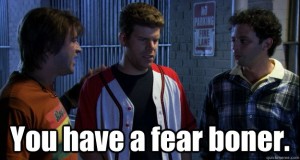There are many popular views about the human mind that, roughly, treat it as a rather general-purpose kind of tool: one that’s not particularly suited to this task or that, but more as a Jack of all trades and master of none. In fact, many such perspectives view the mind as (baffling) being wrong about the world almost all the time. If one views the mind this way, one can be lead into making some predictions about how it ought to behave. As one for instance, some people might predict that our minds will, essentially, mistake one kind of arousal for another. A common example of this thinking involves experiments in which people are placed in a fear-arousal condition in the hopes that they will subsequently report more romantic or sexual attraction to certain partners they meet at that time. The explanation for this finding often hinges on some notion of people “misplacing” their arousal – since both kinds of arousal involve some degree of overlapping physiological responses – or reinterpreting a negative arousal as a positive one (e.g., “I dislike being afraid, so I must actually be turned on instead”). I happen to think that such explanations can’t even possibly be close to true, largely because the response to arousal generated by fear and sexual interest should motivate categorically different kinds of behavior.
Here’s one instance where an arousal mistake like that can be costly
Bit by bit, this view of the human mind is being eroded (though progress can be slow), as it does not fit the empirical evidence or possess any solid theoretical groundings. As a great example of this forward progress, consider the experiments demonstrating that learning mechanisms appear to be eloquently tailored to specific kinds of adaptive problems, since learning to, say, avoid poisonous foods requires much different cognitive rules, inputs, and outputs, than learning to avoid predator attacks. Learning, in other words, represents a series of rather domain-specific tasks which a general-purpose mechanism could not navigate successfully. As psychological hypotheses begin to get tailored more closely to considerations of recurrent adaptive problems, new previously-unappreciated, features of our minds come into stark relief.
So let’s return to the matter of arousal and think about how arousal might impact our day-to-day behavior, specifically with respect to persuasion; a matter of interest to anyone in the fields of marketing or advertising. If your goal is to sell something to someone else – to persuade them to buy what you’re offering – the message you use to try and sell it is going to be crucial. You might, for example, try to appeal to someone’s desire to stand out from the crowd in order to get them interested in your product (e.g., “Think different“); alternatively, you might try to appeal to the popularity of a product to get them to buy (e.g., “The world’s most popular computer”). Importantly, you can’t try to send both of these messages at once (“Be different by doing that thing everyone else is doing”), so which message should you use, and in what contexts should you use it?
A paper by Griskevicius et al (2009) sought to provide an answer to that very question by considering the adaptive functions of particular arousal states. Previous accounts examining how arousal affected information processing were on the general side of things: the general arousal-based accounts would predict that arousal – irrespective of the source – should yield shallower processing of information, causing people to rely more on mental heuristics, like scarcity or popularity, when assessing a product; affect valance-based accounts took this idea one step further, suggesting that positive emotions, like happiness, should yield shallower processing, whereas negative emotions, like fear, should yield deeper processing. However, the authors proposed a new way of thinking about arousal – based on evolutionary theory that suggests those previous theories are too vague to help us truly understand how arousal shapes behavior. Instead, one needs to consider what adaptive functions particular arousal states serve in order to understand when one type of message will be persuasive in that context.
Don’t worry; if this gets too complicated, you can just fall back on using sex
To demonstrate this point, Griskevicius et al (2009) examined two arousal-inducing contexts: the aforementioned fear and romantic desire. If the general arousal-based accounts are correct, both the scarcity and popularity appeals should become more persuasive as people become aroused by romance or fear; by contrast, if the affect valance-accounts are correct, the positively-valanced romantic feelings should make all sorts of heuristics more persuasive, whereas the negatively-valanced fear arousal should make both less persuasive. The evolutionary account instead focuses on the functional aspects of fear and romance: fear activates self-defense-relevant behavior, one form of which would be to seek safety in numbers; a common animal defense tactic. If one were motivated to seek safety in numbers, a popularity appeal might be particularly persuasive (since that’s where a lot of other people are), whereas a scarcity appeal would not be; in fact, sending the message that a product would help make one stand out from the crowd when they’re afraid could actually be counterproductive. By contrast, if one is in a romantic state of mind, positively differentiating oneself from your competition can be useful for attracting and subsequently retaining attention. Accordingly, romance-based arousal might have the reverse effect, making popularity heuristics less persuasive while making scarcity appeals more so.
To test these ideas, Griskevicius et al (2009) induced romantic desire or fear in about 300 participants by having them read stories or watch movie clips related to each domain. Following the arousal-inducing, participants were then asked to briefly examine an advertisement for a museum or restaurant which contained a message that appealed to popularity (e.g., “visited by over 1,000,000 people each year”), scarcity (“stand out from the crowd”), or neither message, and then report on how appealing the location was and whether or not they would be likely to go there (on a 9-point scale across a few questions).
As predicted, the fear condition led to popularity messages to be more persuasive (M = 6.5) than the control advertisements (M = 5.9). However, fear had the opposite effect for the scarcity messages (M = 5.0), making them less appealing than the control ads. That pattern of results was flipped for the romantic desire condition: scarcity appeals (M = 6.5) were more persuasive than controls (M = 5.8), whereas the popularity appeals were less persuasive than either (M = 5.0). Without getting too bogged down in the details on their second experiment, the authors also reported that these effects were even more specific than that: in particular, appeals to scarcity and popularity only had their effects when discussing behavioral aspects (stand out from the crowd/everyone’s doing it); when discussing attitudes (everyone’s talking about it) or opportunities (limited time offer) popularity and scarcity did not differ in their effectiveness, regardless of the type of arousal being experienced.
One condition did pose interpretive problems, though…
Thinking about the adaptive problems and selection pressures that shaped our psychology is critical for constructing hypotheses and generating theoretically plausible explanations for understanding its features. Expecting some kind of general arousal, emotional valance, or other such factors to explain much about the human (or nonhuman) mind is unlikely to pan out well; indeed, it hasn’t been working out for the field for many decades now. I don’t suspect such general explanations will disappear in the near future, despite their lack of explanatory power, though; they have saturated much of the field in psychology and many psychologists lack the necessary theoretical background to fully appreciate why such explanations are implausible to begin with. Nevertheless, I remain hopeful that someday the future of psychology might not include reams of thinking about misplaced arousal and general information processing mechanisms that are, apparently, quite bad at solving important adaptive problems.
References: Griskevicius, V., Goldstein, N., Mortensen, C., Sundie, J., Cialdini, R., & Kenrick, D. (2009). Fear and loving in Las Vegas: Evolution, emotion, and persuasion. Journal of Marketing Research, 46, 384-395.




Pingback: Examining Arousal And Homophobia | Pop Psychology